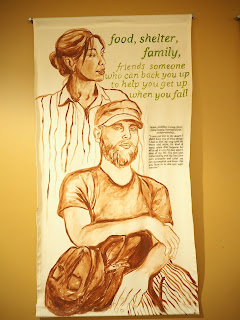Transatlantic Practice Exchange Day Three: Coordinated Entry
I’m a huge believer in the idea of No Wrong Door; that no
matter what door someone knocks on to receive help it should be opened widely,
they should be received warmly and they should leave with the information and the
support that they need.
I’m also a huge believer in fair access to services for
everyone; this is never as important as when resources are scarce.
Grand Rapids currently uses a system called Coordinated
Entry and I love it! It’s a system that combines these principals and informs
system’s change.
This morning I was lucky enough to be invited to a meeting
with a range of support and housing providers from across the city as they
discussed the process.
Coordinated Entry aims to “efficiently and effectively
connects the homeless people in our community to housing resources”.
The service offers walk in services, appointments and a
phone line. Everyone experiencing homelessness contacts the service is assessed and allocated to
appropriate housing resources.
The call can be made directly by the client or they can walk
through the door of any of the services they know and trust and ask for support
to make the call.
This means that access to housing is completely fair, it
does not depend on someone’s engagement or relationship with services, and, as
all housing applications are made in one place, it gives Coordinate Entry an
accurate picture of both the available resources and the people in the
community who need them.
Michigan are one of a few areas that have a state-wide CRM
system used by almost all of the housing and support agencies in the city. Agencies
can check the status of their clients’ referrals into housing agencies and
whether they are accepted or declined. This provides a basis for important conversations
between services. If referrals are repeatedly declined it allows them to look
at whether things need to change. Do Coordinated Entry staff need more training
on the services eligibility requirements? Do the services entry requirements need
to bend to meet the needs of the populations they serve?
It made me think about how effectively the voluntary sector engages
with our councils’ homelessness process in the UK. Particularly for people
experiencing multiple disadvantage. Often this client group will move from
rough sleeping to permanent accommodation without ever having contact with
services. No homelessness application is made, so no official record of their
homelessness exists. This data is vital to demonstrate the demand for housing. Demonstrating the demand for housing is vital for ending homelessness.
Maybe the basis of our own Coordinated Entry system is right
under our noses. We just need to make sure we use it.
*I took the first two images from an exhibition by artist Erika Magers whose work for Grand Rapids Art Prize 2009 where she explored the idea of basic needs by painting a collection of portraits of everyday people, displayed at United Way.
The third image is of the room where the meeting took place at United Way, Grand Rapids.





Comments
Post a Comment